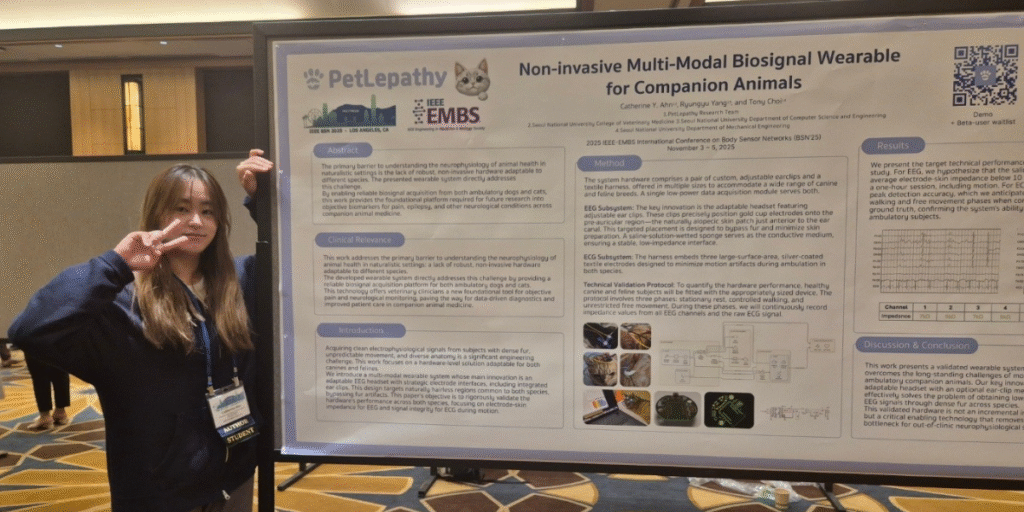Johns Hopkins Biotech Symposium, AGI House Award-winning startup, backed by 6 IEEE conference peer-reviewed papers and a U.S. patent, pioneers cross-species non-verbal communication, scaling from pets to humans.
Bridging the Gap Between Humans and Their Silent Companions
Pets are masters at hiding pain, and this silence has real consequences. Behind every wagging tail or gentle purr, millions of animals endure discomfort that goes unseen and untreated. For Catherine Ahn, founder and CEO of PetLepathy, this wasn’t just an abstract problem, it was personal. When her 13-year-old cat grew ill, the signs went unnoticed until she vomited blood. That moment of heartbreak sparked a mission to build a technology that would ensure no animal’s suffering would ever be overlooked again.
From that origin, PetLepathy was born: an AI-driven biosignal platform that decodes what animals feel but cannot express. Using non-invasive sensors and multimodal artificial intelligence, PetLepathy bridges the emotional divide between pets and people, turning empathy into measurable insight.
Turning Empathy Into Engineering
Ahn’s vision quickly evolved from a personal project into a globally recognized scientific initiative. PetLepathy’s team developed a non-invasive wearable that captures EEG and HRV data to detect pain and emotional states in animals with an 86% accuracy rate, a remarkable achievement in animal behavior analytics.
“Pets often hide signs of pain,” Ahn explains. “That experience with my own cat made me realize the need for technology that could tell us how our pets are really feeling.”
What sets PetLepathy apart is its commitment to multimodal AI, fusing diverse biosignals to reveal patterns that single-signal trackers like PetPace or Whistle simply can’t detect. While competitors interpret isolated data points such as heart rate or activity, PetLepathy’s model reads multiple biological “languages” at once, offering nuanced, real-time understanding of animal health.
Building the Science Behind Empathy

Behind PetLepathy’s innovation is a foundation of rigorous research. In just three months, the company achieved what many universities take years to accomplish, six peer-reviewed papers accepted at three IEEE conferences, including research on multimodal biosignal modeling, EEG foundation architectures, and sensor feasibility in canine heart rate variability.
These papers, spanning titles like A Cross-Species Foundation Model for Biosignals and Neuro-MambaGraph: A Foundation Model for Spatio-Temporal EEG Representation Learning, mark an extraordinary milestone for a young company. They also demonstrate PetLepathy’s emergence as a leader in cross-species biosignal AI, a field that connects human neuroscience and animal communication.
This scientific momentum didn’t go unnoticed. PetLepathy earned the AGI House AI4Science Hackathon Special Prize and an award-winning presentation at the Johns Hopkins University Biotechnology Innovation Symposium, both recognizing the company’s pioneering role in bridging biology and AI. The startup also placed 2nd among 336 competitors in a Korea Startup Competition, cementing its reputation as a rising global innovator.

Ethically Sourced Data and a Compassionate Moat
PetLepathy’s success isn’t just about technical brilliance, it’s built on ethics and empathy. The company’s unique “Compassion Moat” strategy involves adopting and monitoring rescued animals during recovery, creating a proprietary multi-species biosignal dataset that captures emotion, pain, and healing across both humans and animals.
This approach ensures that every data point reflects genuine compassion, transforming research into a moral framework for humane innovation. By ethically sourcing its data, PetLepathy is constructing what may become the world’s first cross-species emotional intelligence model, one capable of decoding pain, stress, and empathy in entirely new ways.
That foundation has already translated into tangible innovation: the U.S. Patent and Trademark Office (USPTO) recently granted PetLepathy a provisional patent for its non-invasive animal EEG system, officially recognizing the company’s originality and leadership in animal biosignal research.
From Pets to People: Scaling Empathy Across Species
PetLepathy’s journey is more than a technological breakthrough, it’s a redefinition of what it means to understand life. The same multimodal AI models now decoding canine emotions could one day advance human mental health, livestock welfare, and even biofeedback therapies.
By mapping emotional patterns across species, PetLepathy is pioneering the world’s first framework for cross-species empathy modeling, a step toward a future where human and animal well-being are intertwined through shared biosignals.
At its core, the company’s philosophy remains simple yet revolutionary: data should make us more humane.
Leading the Next Era of Animal Communication
Every milestone, from six peer-reviewed papers to global innovation awards and patent recognition, reflects a deeper truth: PetLepathy isn’t just developing devices; it’s building understanding.
“Our ultimate goal,” Ahn says, “is to create a future where no animal suffers without being noticed, and no owner is left wondering how their pet is feeling.”
With compassion as its foundation and science as its language, PetLepathy is defining the next era of animal care, one where empathy is measurable, communication is mutual, and technology gives every living being a voice.
Join the Revolution in Animal Understanding
PetLepathy invites veterinarians, pet owners, and animal enthusiasts to experience the future of compassionate technology. Stay connected with PetLepathy through LinkedIn, X, and Instagram to follow their journey toward revolutionizing animal care.
